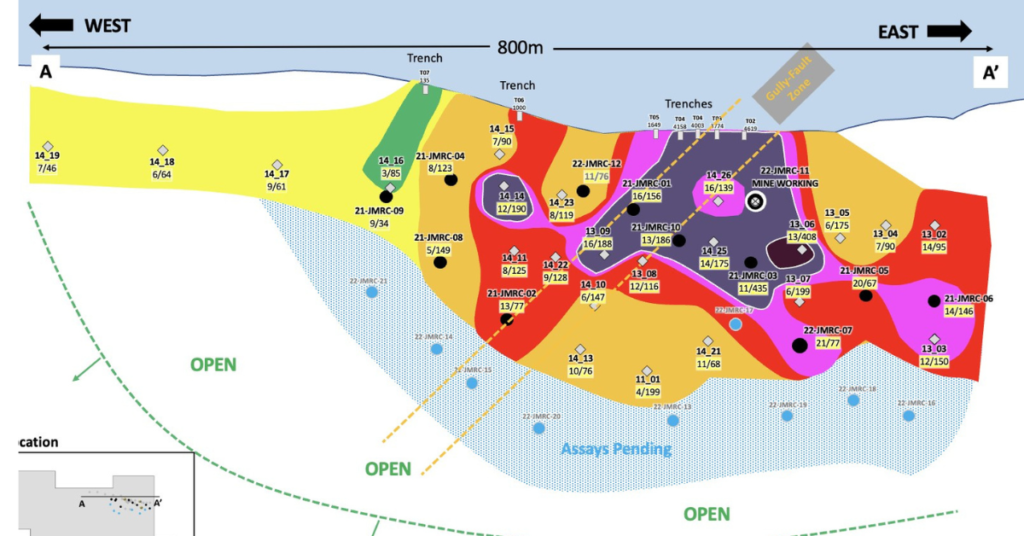Vancouver, British Columbia–(Newsfile Corp. – June 29, 2022) – Capitan Mining Inc. (TSXV: CAPT) (“Capitan” or the “Company”) is pleased to report continued exploration results from three (3) reverse circulation (RC) drillholes, as well provide an exploration update on the progress to date at its 100% owned Jesús María Silver Zone, at the Cruz de Plata Project (Formerly referred to as Peñoles), Durango, Mexico.
Highlights:
- Hole 22-JMRC-12: returned two high-grade intervals of 1.5m of 488.97 g/t AgEq and 1.5m of 328.25 g/t AgEq within 21.3m of 143.59 g/t AgEq
- Hole 21-JMRC-07: returned 1.5m of 427.62 g/t AgEq within 22.9m of 76.98 g/t AgEq
- Capitan Mining publishes first long section of Jesus Maria Silver Vein
- Mineralization has been confirmed over 800m of strike length, with drilling continuing to confirm high-grade mineralization at depth
- Assays are pending for 9 RC drill holes from the Jesus María zone, with 8 drilled to test down-dip extension of the vein
Step-out and Infill holes Continue to Confirm Continuity of High-grade Mineralization
The drill holes reported herein consist of both infill and step-out holes targeting the continuity of high-grade mineralization and the expansion of Jesus Maria style mineralization at depth.
Drillholes 22-JMRC-11 and 12 were both infill holes, targeting the eastern and western extents of high-grade mineralization associated with the Gully Fault, as shown on the long section below (Figure 1). 22-JMRC-11 intersected mine workings at the interpreted depth of high-grade mineralization associated with the Gully Fault and returned several zones of generally narrow mineralization thereafter at depth. Hole 22-JMRC-12 returned a stronger zone of high-grade mineralization near surface consisting of 21.3m of 143.59 g/t AgEq, including 1.5m of 488.97 g/t AgEq and 1.5 of 328.25 g/t AgEq. Of note, the high-grade intersections in hole 22-JMRC-12 extended the boundary of high-grade mineralization northeast along the Gully Fault structure and not along the Main Jesus Maria Vein (long section below), which trends east-west. The technical team is in the process of generating a long-section for the Gully Fault, as well as other sub-parallel zones at Jesus Maria. Figure 5 shows a 3D perspective view showing the relationship between the Jesus María Vein and the Gully Fault Zone.
Drillhole 22-JMRC-07 was a step-out hole that was designed to extend the Jesus Maria zone to depth, along section. The hole successfully intersected the Jesus Maria zone at 112.8m downhole, returning 22.9m of 76.98 g/t AgEq including 1.5m 427.62 g/t AgEq and extending the zone down-dip approximately 25m, (see long-section and cross section below).
Exploration Update: Drilling at Jesus María Continues to Define High-Grade Silver Mineralization and Extend Zone at Depth
The Jesus María vein is part of a larger trend of silver-mineralized veins that occur on a 3-km east-northeast trend, between the zones of Jesus Maria and San Rafael, with most of that trend covered by the Capitan Mining mineral concessions.
The Jesus Maria vein has been drill tested over a strike length of 800m, including new drilling, with most of this drilling focused over a 475m strike length, from the Gully Fault structure eastward, with the remaining 325m to the west remaining shallowly drilled. The entire zone remains open at depth. The current drill program has focused on two objectives:
- To extend mineralization along strike and at depth through step-out drilling
- To better define high-grade shoots along the Jesus Maria and Gully-Fault structures through infill drilling
The long section shown below in Figure 1, illustrates the distribution of high-grade mineralization along the main Jesus Maria Vein, indicated by the red, magenta, and purple shading. Of note, is the clustering of high-grade mineralization coincident with and adjacent to, the trace of the Gully Fault. Recent infill drilling within this corridor has confirmed that the Gully Fault exhibits a strong control on the distribution of high-grade mineralization along Jesus Maria vein, with additional high-grade mineralization hosted along the Gully Fault structure itself. The current drill program has been successful in showing that the high-grade mineralization at surface continues at depth, forming a continuous zone of high-grade Ag-mineralization along the central and eastern portions of the Jesus Maria Vein.
In addition, high-grade mineralization has been expanded to the south and east through recent step-out drilling, indicating that mineralization continues to remain strong and open at depth.
Going forward, an additional 9 holes are pending assays, with their respective locations shown on the long section below. Most of these holes are step-outs down-dip, with only two designated as infill. In addition, the long-section presented below in Figure 1 represents one of two main zones currently being targeted in the current drill program. A long-section for the Gully Fault target is currently in process and should be ready in the coming weeks.
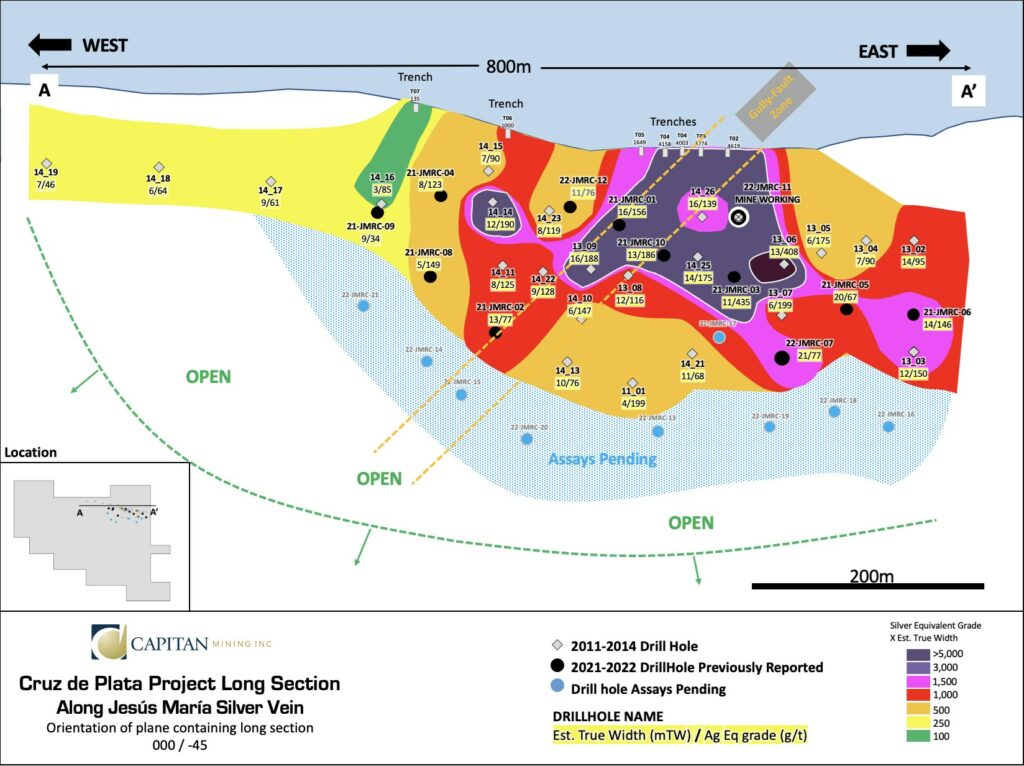
To view an enhanced version of Figure 1, please visit:
https://orders.newsfilecorp.com/files/7373/129377_8ea2948da4734884_002full.jpg
Capitan’s CEO, Alberto Orozco, stated: “Our understanding of the silver potential at the Cruz de Plata has grown greatly since our drilling started in the Jesus Maria vein last year. We have not only demonstrated the scale potential for that vein by expanding on the main mineralized plunges within it, but have also identified additional structures or veins that hold further potential. This includes the Gully-Fault Zone, the Upper Jesus María vein, Jesus-Maria stye mineralization underneath the Capitan oxide gold deposited (as reported in hole 21-CARC-29) and new mineralization and alteration zones in the footwall of the Jesus Maria vein. We are excited to see results for upcoming holes testing the down-dip component of Jesus Maria, as well as to continue our drill program testing further targets.”
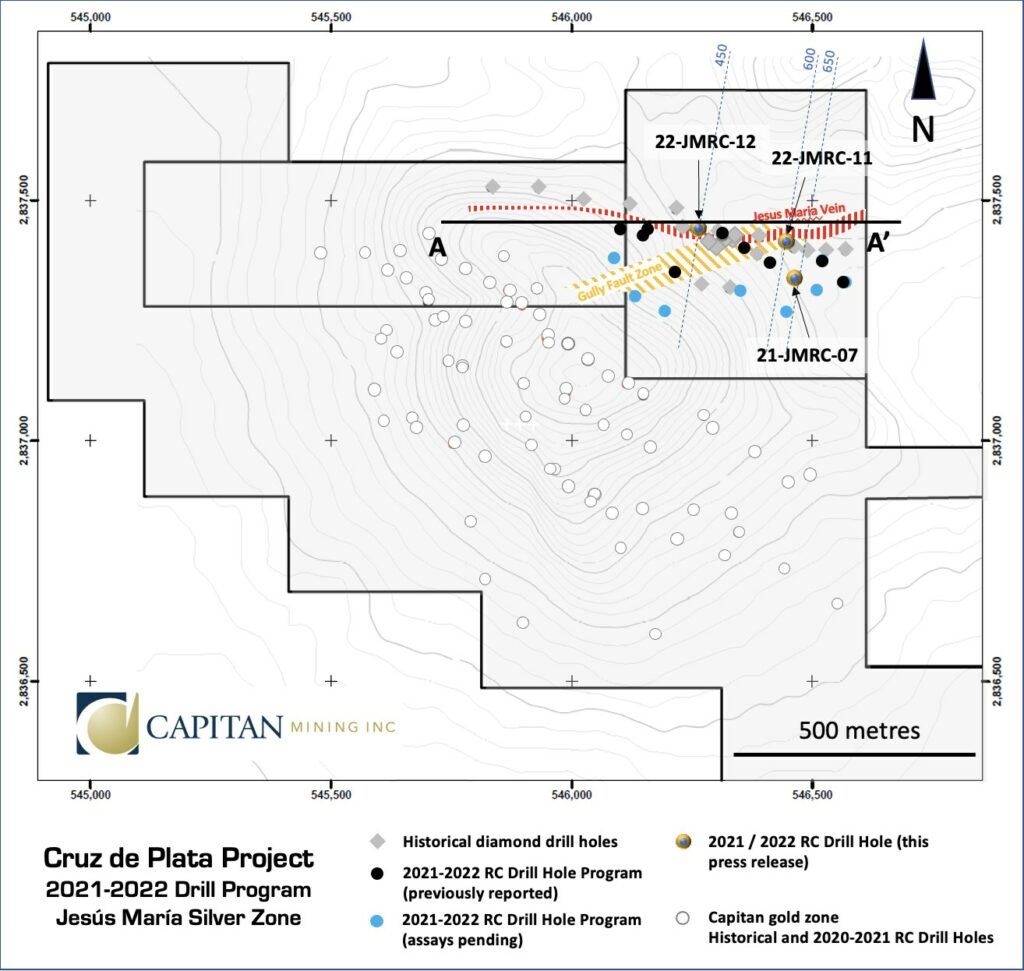
To view an enhanced version of Figure 2, please visit:
https://orders.newsfilecorp.com/files/7373/129377_8ea2948da4734884_003full.jpg
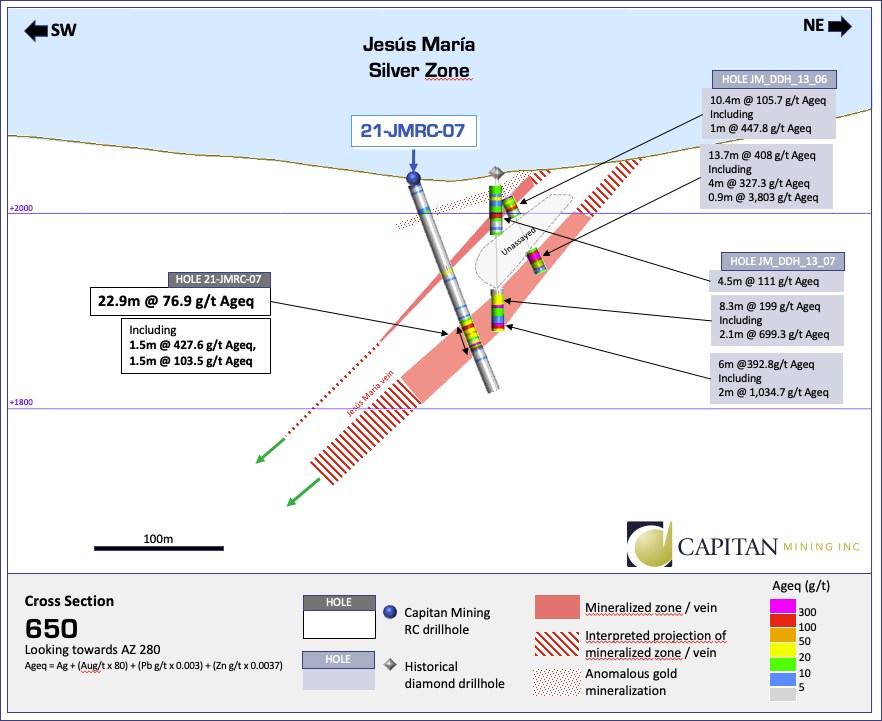
To view an enhanced version of Figure 3, please visit:
https://orders.newsfilecorp.com/files/7373/129377_8ea2948da4734884_004full.jpg
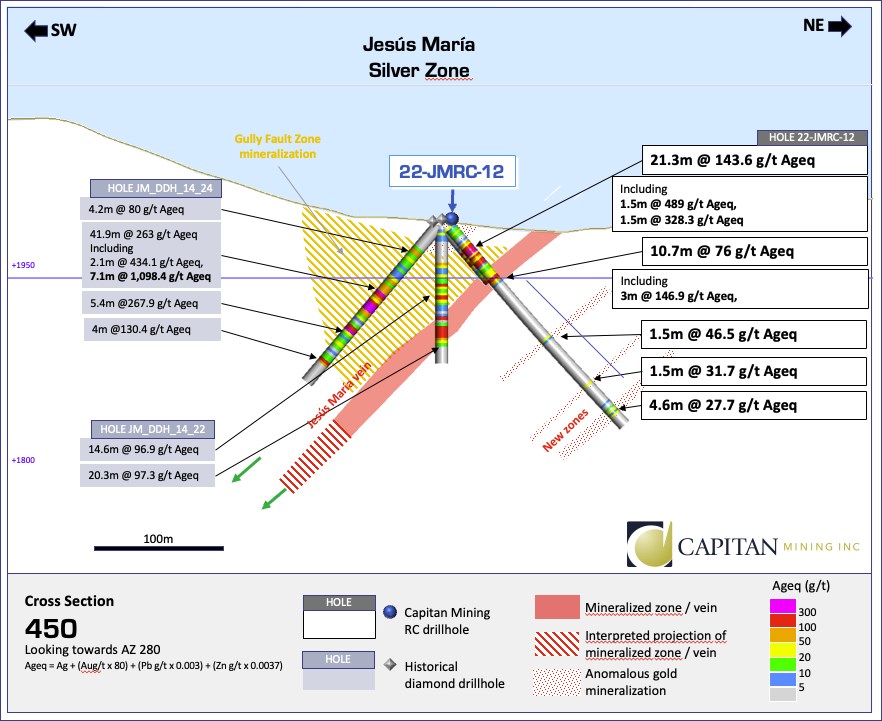
To view an enhanced version of Figure 4, please visit:
https://orders.newsfilecorp.com/files/7373/129377_8ea2948da4734884_005full.jpg
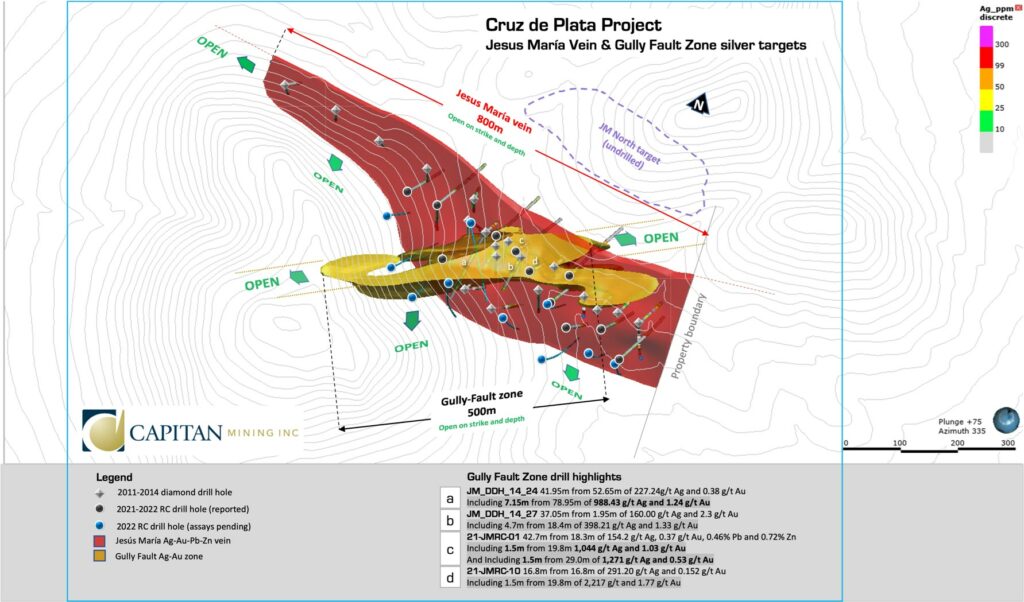
To view an enhanced version of Figure 5, please visit:
https://orders.newsfilecorp.com/files/7373/129377_8ea2948da4734884_006full.jpg
Table 1. Table of drill results for hole 21-JMRC-07, 22-JMRC-11 and 22-JMRC-12
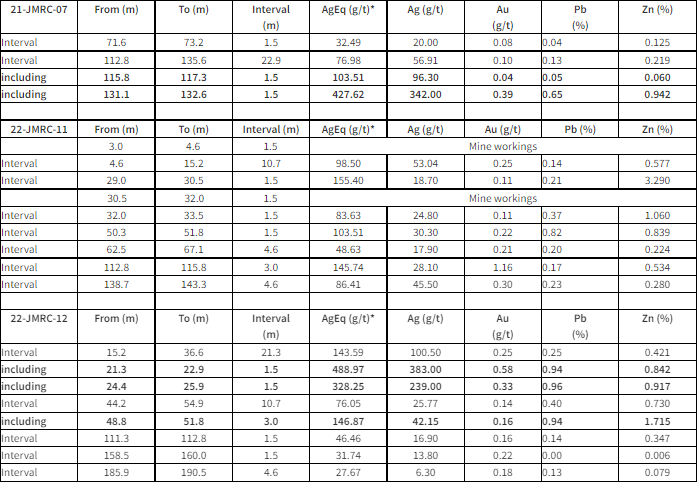
Note: Only drill intercept lengths are reported in the table. Drill holes are designed to cut the mineralized zones as close to true width as possible, with true widths ranging from 70-95% of the reported drilled length.
* Silver equivalent calculated using the following equation AgEq = Ag g/t + (80 x Au g/t) + (0.003 x Pb g/t) + (0.0037 x Zn g/t).
About the Jesus María Silver Project
The Jesus Maria (JM) Silver Project is located approximately 280m to the northeast of the Capitan’s Oxide Gold deposit on its 100% owned Cruz de Plata property. It has been traced by surface trenching and diamond drilling over a strike length of 800m and to a depth of 200m, with the majority of drilling focused over 475m of strike length and less than 150m below surface.
The Jesus Maria Silver Project has a long mining history going back to the late 1800’s, when the Penoles Mining company constructed several shafts and drifts to exploit the high-grade silver veins in the area. In recent years, work programs conducted by previous operators has demonstrated significant potential at the Jesus Maria silver deposit. The work to date has identified Two (2) distinct styles of silver mineralization:
- High-grade silver polymetallic veins (Silver gold lead-Zinc)
- High-grade silver with gold veins
Highlights of trenching and diamond drilling by previous operators are presented below:
Prior Trenching Highlights – Jesus Maria (2011-2013)
- 22m of 224g/t Ag, 1.08 g/t Au, 2.5% Pb and 1.7% Zn (2011)
- 8.3m of 144 g/t Ag, 1.68 g/t Au, 2.4% Pb and 2.2% Zn (2011)
- 13.4m of 309 g/t Ag, 1.7 g/t Au. 2.4% Pb and 0.6% Zn (2011)
- 2m of 2,152.2 g/t Ag and 0.48 g/t Au, within a wider interval of 15.4m of 420.8 g/t Ag, 0.15 Au (2013)
- 2m of 378.9 g/t Ag and 0.97 g/t Au,within a wider interval of 15.8m of 129.8 g/t Ag and 0.16 g/t Au (2013)
Prior Diamond Drill Highlights – Jesus Maria (2013-2014)
High-grade Silver Polymetallic veins
- JM-DDH-13-06: 0.9m of 3,409.1 g/t Ag, 0.9 Au, 3.4% Pb and 7.1% Zn within a wider interval of 11.85m of 320.3 g/t Ag and 0.17 Au
- JM-DDH-13-07: 2.1m of 279.5 g/t Ag, 0.21 g/t Au, 4.09% Pb and 7.57% Zn
- JM-DDH-14-10: 2.3m of 113.8 g/t Ag, 0.82 g/t Au, 4.3% Pb and 1.8% Zn
High Grade Silver & Gold Veins
- JM-DDH-14-24: 7.15m of 988 g/t Ag and 1.24 g/t Au within a wider interval of 70.8m of 147.8 g/t Ag, 0.37 g/t Au
- JM-DDH-14-10: 4.25m of 732.2 g/t Ag, 1.2 g/t Au, within a wider interval of 40.6m of 123.9g/t Ag and 0.54 g/t Au
- JM-DDH-13-07: 2m of 988.5 g/t Ag, 0.23 g/t Au within an interval of 4m of 533 g/t Ag and 0.16 g/t Au
- JM-DDH-14-27: 4.7m of 398 g/t Ag and 1.33 g/t Au within a wider interval of 47m of 125 g/t Ag and 0.4 g/t Au
Approximately 3,100m of diamond drilling were completed by previous operators at the Jesus Maria silver deposit (2011-2014), which were used to complete an initial 43-101 compliant, Inferred resource in 2015 consisting of 7.5 million tonnes at an average grade of 62 g/t Ag (15 million contained ounces) and 0.1 g/t Au (26,000 contained ounces). Capitan has submitted an updated 43-101 report on the Cruz de Plata project inferred resource (formerly called Peñoles project), with an effective date of January 12, 2020. The report was authored by Derrick Strickland, P. Geo. And Robert Sim, P. Geo. The report can be found in SEDAR.
Qualified Person & QA/QC:
The scientific and technical data contained in this news release pertaining to the Peñoles Project was reviewed and approved by Marc Idziszek, P.Geo, a non-independent qualified person to Capitan Mining, who is responsible for ensuring that the technical information provided in this news release is accurate and who acts as a “qualified person” under National Instrument 43-101 Standards of Disclosure for Mineral Projects.
Capitan Mining Inc. has a Quality Assurance/Quality Control program that includes insertion and verification of control samples including standard reference material, blanks and duplicates consistent with industry standards.
RC drill samples from the Peñoles Project are collected and split at the drill site using a Gilson Universal Splitter. The samples are stored in either plastic bags (dry) or micropore bags (wet) and secured with plastic zip-ties and then transported to the preparation laboratory of Bureau Veritas in Hermosillo, Sonora. The sample pulps are then transported to the Bureau Veritas’ laboratory in Vancouver, where they are assayed for gold by fire assay with atomic absorption finish (FA430 assay method code; 0.005 to 10 ppm detection limit). Samples over 10 ppm Au and over 100 ppm Ag are assayed with gravimetric finish (Assay code FA530). All samples are also assayed by ICP-ES (code AQ300) for a suite of 33 elements. Samples over 1%Pb and Zn are assayed by Aqua regia Ore Grade ICP-ES (AQ 370).
All summarized intervals reported in this press release were calculated using a 25 ppm Ag equivalent (AgEq) cut-off grade with AgEq including Ag, Au, Pb and Zn and calculated as follows: AgEq = Ag g/t + (80x Au g/t) + (0.003 x Pb g/t) + (0.0037 x Zn g/t). Intervals contain no more than 3 metres of internal dilution. High grades have not been capped. 100% recovery for all metals is assumed.
About Capitan Mining Inc.:
Capitan Mining is a well-funded junior exploration company focused on its 100% owned gold and silver Peñoles Project in Durango, Mexico. The company is led by a management team that has successfully advanced and developed several heap leach operations in Mexico over the past 16 years. More information for the Company can be found at www.capitanmining.com.
ON BEHALF OF CAPITAN MINING INC.
“Alberto Orozco”
Alberto Orozco, CEO
For additional information contact:
Alberto Orozco
CEO
Capitan Mining Inc.
info@capitanmining.com
Phone: (778) 327-6671
Fax: (778) 327-6675
Web: www.capitanmining.com
Raffi Elmajian
Corporate Communications
Capitan Mining Inc.
info@capitanmining.com
Phone: (604) 358-2601
Web: www.capitanmining.com
Certain statements in this press release may be considered forward-looking information. These statements can be identified by the use of forward-looking terminology (e.g., “expect”,” estimates”, “intends”, “anticipates”, “believes”, “plans”). Such information involves known and unknown risks — including the availability of funds, the results of financing and exploration activities, the interpretation of exploration results and other geological data, or unanticipated costs and expenses and other risks identified by Capitan in its public securities filings that may cause actual events to differ materially from current expectations. Readers are cautioned not to place undue reliance on these forward-looking statements, which speak only as of the date of this press release.
Neither the TSX Venture Exchange nor its Regulation Services Provider (as that term is defined in the policies of the TSX Venture Exchange) accepts responsibility for the adequacy or accuracy of this release.
Original Article: https://www.newsfilecorp.com/release/129377
